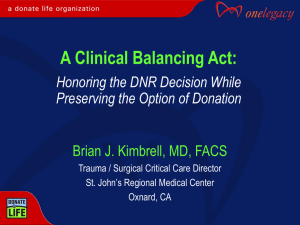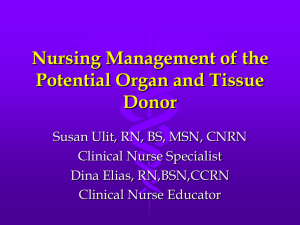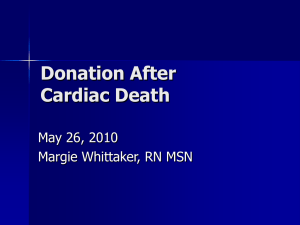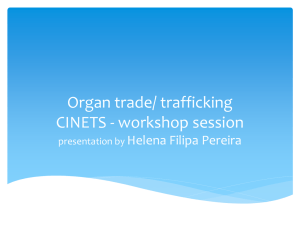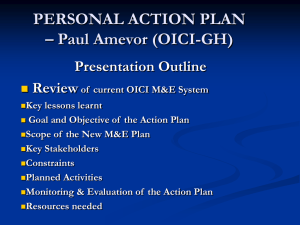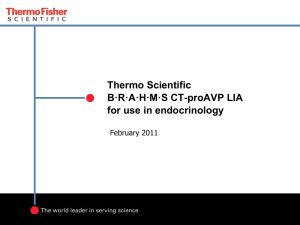Preserving the Opportunity
advertisement
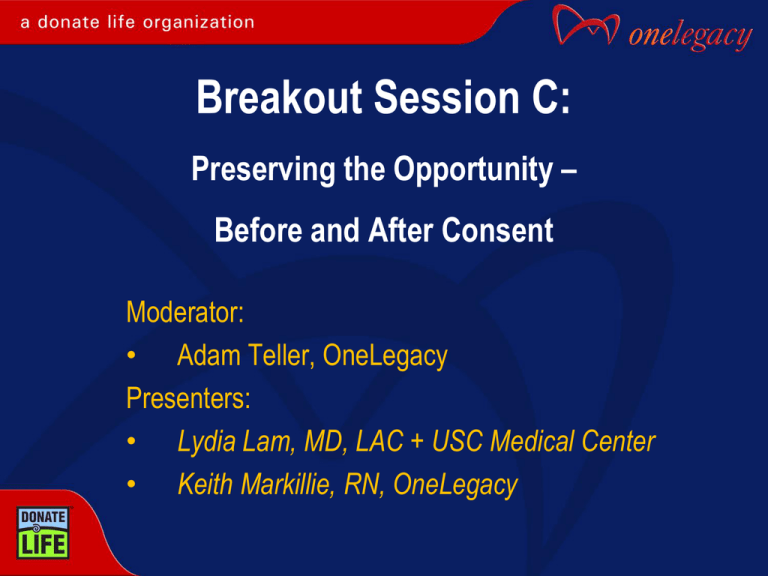
Breakout Session C: Preserving the Opportunity – Before and After Consent Moderator: • Adam Teller, OneLegacy Presenters: • Lydia Lam, MD, LAC + USC Medical Center • Keith Markillie, RN, OneLegacy Preserving the Opportunity: Before and After Consent Moderator: Adam Teller, Procurement Transplant Coordinator OneLegacy “How To Be” Being in Action! The Answers Are In the Room “Report out” on Questions to Run-on: Scribe Spokesperson All Teach / All Learn Question to Run-On How do your standards of care preserve the opportunity for the gift of life? Objectives By the end of this presentation, the attendee will be able to: 1. Understand the impact of a DNR and donation 2. Recognize pathophysiology of traumatic brain injury 3. Anticipate common interventions for optimal donor management Lydia Lam, MD Division of Acute Care Surgery and Surgical Critical Care Los Angeles County + USC Medical Center Los Angeles, CA DNR Decision What does the DNR decision mean to the family? No Chest Compressions? No Shock? No Medications? No Labs? No Fluids? No Diagnostic Tests? Allow natural death? “Do not harm?” or “Do not treat?” DNR Decision What does the DNR decision mean to the healthcare team? Routine decision in the Critical Care Unit Stop all treatment immediately or no aggressive treatment after cardiac arrest? DNR decision has its own “culture of understanding” that varies by hospital, unit, physician and nurse “Do not harm?” or “Do not treat?” Donation Decision Understanding the donation option clinically: Maintaining blood pressure Normalizing electrolytes Managing oxygenation and organ perfusion Balancing Intake and Output Assessing brain death accurately How can a family give the gift of life when the organs are not preserved for transplantation? Balancing DNR and Donation Traumatic Brain Injury (TBI) Overall Clinical Deterioration + DNR Decision by Next-of-Kin + Fatal Diagnosis (Brain Death?) How is this interpreted in your ICU? What can be expected from your team? How can we be proactive for this family? Pathophysiology of Traumatic Brain Injury Physiologic collapse frequently accompanies TBI: Hypotension Endocrine Dysfunction Pulmonary Dysfunction Hematologic Dysfunction Pathophysiology of Traumatic Brain Injury Hypotension: “Autonomic storms” Smooth muscle ATP depleted = vasomotor hypotension Anticipate BP spike followed by BP drop Titrate Vasopressors Diuretics Consider Fluid Resuscitation Closely monitor Intake and Output – DI? Pathophysiology of Traumatic Brain Injury Endocrine Dysfunction: Hypothalamic injury -> pituitary dysfunction Thyroid dysfunction = T4 Infusion Reduction of Antidiuretic Hormone / DI ADH = Vasopressin Infusion Glycemic control disrupted Insulin infusion Relative deficiency of corticosteroids Solumedrol Infusion Pathophysiology of Traumatic Brain Injury Pulmonary Dysfunction: Neurogenic pulmonary edema Systemic hypertension + LV dysfunction Primary pneumatocyte dysfunction Iatrogenic injury due to aggressive resuscitation Exacerbated by intubation, aspiration &atelectasis Concurrent blunt lung injury common Parenchymal injury problematic in immunosuppressed recipients Pathophysiology of Traumatic Brain Injury Hematologic Dysfunction: Thrombocytopenia Platelets as needed Coagulopathy/DIC FFP / Cryo as needed Hypothermia Keep them warm! What are Traumatic Brain Injury Guidelines? Hospital approved guidelines for treating patients with Traumatic Brain Injury What are Traumatic Brain Injury Guidelines? Prevent secondary injury, even with grave prognosis Secondary injury includes other organs, as well as the brain Maintain Organ Perfusion Volume Load Maintain adequate CVP & MAP Oxygenation Correct electrolyte abnormalities Why Implement Traumatic Brain Injury Guidelines? Ensure consistent management of the critically ill patient Maintain homeostasis for accurate brain death assessment Prevent “secondary injury” to organs, even with grave prognosis Provide a clinical bridge between determination of brain death and family’s decision on donation Aggressive Organ Donor Management Significantly Increases the Number of Organs Available for Transplantation (Salim et al. J Trauma 2005; 58: 991-994) LAC + USC Standardized organ donor management protocol Before-after study (January 1998) of ADM institution January 1995-December 2002 Aggressive Organ Donor Management Significantly Increases the Number of Organs Available for Transplantation (Salim et al. J Trauma 2005; 58: 991-994) Vasopressors if MAP <70 Dopamine Levophed Vasopressin Hormones for maximal vasopressors. Insulin Solumedrol T4 Aggressive Organ Donor Management Significantly Increases the Number of Organs Available for Transplantation (Salim et al. J Trauma 2005; 58: 991-994) 878 patients referred, 460 (53.4%) patients potential organ donors and 161 (34.3%) actual donors. # patients referred increased 57% # of potential donors increased 19% # of actual donors increased 82% # of patients lost to cardiovascular collapse decreased 87% # of organs recovered increased 71% How to Implement TBI Guidelines in your Hospital? Clinical Educator Critical Practice Committee Critical Care Leadership Critical Care Physicians or Medical Director Sample Guidelines available at: www.onelegacy.org DNR Decision What does the DNR decision mean to the family? No Chest Compressions? No Shock? No Medications? No Labs? No Fluids? No Diagnostic Tests? Allow natural death? “Do not harm?” or “Do not treat?” Summary Critical care teams can honor the DNR decision while preserving the option of donation. Pathophysiology of Traumatic Brain Injury can be anticipated and treated. TBI Guidelines can be implemented to prevent “step down” in clinical management and preserve the family’s donation option. The Care and Management of Consented Brain Dead Organ Donors Keith Markillie PTC, RN, BSN OneLegacy Best Practices Approach to Saving Lives & Preserving the Opportunity for Organ Donation Organ Donor Management Similar to Traumatic Brain Injury Guidelines: “What’s good for the patient is good for the donor” Treatment of Brain Death – Standardizes donor management within OneLegacy – Maximize the organs recovered per donor Organ Donor Management 1. 2. 3. 4. MAP 60 – 110 mmHg CVP 4 - 12mmHg EF > 50% </= 1 pressor used AND: a. Dopamine </= 10 mcg/kg/min b. Neosynephrine </= 100 mcg/min c. Norepinephrine </= 10 mcg/min d. Vasopressin </= 2.4 units/hour (0.04 units/min) 5. ABG pH 7.3-7.5 1. PaO2:FiO2 ratio >300 on PEEP = 5 2. Serum Sodium <155 3. Urine output 1-3 mL/kg/hour 4. Glucose < 150 5. Hemoglobin > 10 Track hormone replacement usage Hormonal Replacement Post brain death endocrine changes – There is a sharp decrease in T3 and T4 to 50% of normal within one hour of brain death & down to Zero after 16 hours – Cortisol levels decrease to 50% after one hour and continue to decrease – Antidiuretic Hormone decrease significantly and completely disappear after 6 hours – Insulin decreased to 20% of baseline by 13 hours >>Transplantation, Vol 83, pp 1396-1402, no 11, December 15, 2006 Hormonal Imbalances Research findings suggest that after brain death aerobic metabolism changes to anaerobic cellular metabolism ATP and creatinine phosphate deplete & lactate increases which leads to decreased cardiac function After T4 infusion, lactate decreases, glucose utilization increases and the mitochondria resume aerobic energy generation >>Transplantation, Vol 83, pp 1396-1402, no 11, December 15, 2006 T-4 Protocol Give IV boluses of the following: – – – – 20 mcg T-4 IV push 20 units regular insulin 50 mL dextrose 50% 30 mg/kg Solumedrol (2 grams max) After initial bolus start T-4 drip – 200 mcg in 500mL NS at 25mL/hour initially (10 mcg/hour) – Titrate as needed to maintain BP – Continue drip to procurement Solumedrol Used in conjunction with T-4 Corticosteroid replacement for lowered cortisol levels in brain dead patients Used routinely throughout care of the donor Vasopressin/Pitressin Used as hormone replacement of ADH from posterior pituitary gland in brain dead patient Very effective in treating DI related hypotension May or may not give 1 unit IV bolus of vasopressin before starting drip Drip rate is 0.5 – 2.4 units/ hour Closely observe Urine Output—don’t make the donor anuric Insulin Monitor glucose every 2 hours Treat with insulin drip rather than SQ Keep 80-150 Utilize hospital or OneLegacy protocol Treatment beyond Hormones Organ Perfusion Balance electrolytes Correct coagulopathy Correct metabolic acidosis Optimize oxygenation and ventilation Antibiotic usage Organ Perfusion Maintain MAP 60 – 110mmHg 1. Consider invasive hemodynamic monitoring 2. Adequate hydration to maintain euvolemia • Crystalloids, colloids, blood products • Free water 3. Vasopressor support • Dopamine • Vasopressin • Neosynephrine • Levophed 4. 2D Echo to evaluate function once resuscitated & pressors low dose Balance Electrolytes Monitor and treat electrolytes maintaining: Sodium: 134 – 145 mMol/L Potassium: 3.5 – 5.0 mMol/L Magnesium: 1.8 – 2.4 mEq/L Phosphorus: 2.0 – 4.5 mg/dL Ionized Calcium: 1.12 – 1.3 mmol/L Correct Coagulopathy Maintain normothermia 36 – 37.5 degrees Celsius (96.8 – 99.5 degrees Fahrenheit) Maintain hemoglobin > 10.0 g/dL & hematocrit > 30% If PT > 2.0, consider transfusion of FFP If Fibrinogen is 70 - 100, consider FFP. If < 70, consider cryoprecipitate If platelets < 50, consider platelet transfusion Metabolic Acidosis Adequate perfusion Volume resuscitation Sodium Bicarbonate Use judiciously with high sodium Find other reasons for acidosis (respiratory, kidney failure, electrolytes) Use potassium and sodium acetate to supplement electrolytes Oxygenation/Ventilation Early bronchoscopy to clear secretions Routine use of Solumedrol Good pulmonary toileting Breathing treatments/MDI Narcan early Lung recruitment – PEEP maneuvers – I:E ratio manipulation Antibiotic Usage ALL patients get antibiotics! Dosages can be adjusted to size and kidney clearance Less than 5 days = Zosyn Greater than 5 days = Vancomycin + Levaquin May need other coverage, depending on predonor condition ID consult? Never a bad idea with “strange circumstances” Organ Donor Management 1. 2. 3. 4. MAP 60 – 110 mmHg CVP 4 - 12mmHg EF > 50% </= 1 pressor used AND: a. Dopamine </= 10 mcg/kg/min b. Neosynephrine </= 100 mcg/min c. Norepinephrine </= 10 mcg/min d. Vasopressin </= 2.4 units/hour (0.04 units/min) 5. ABG pH 7.3-7.5 1. PaO2:FiO2 ratio >300 on PEEP = 5 2. Serum Sodium <155 3. Urine output 1-3 mL/kg/hour 4. Glucose < 150 5. Hemoglobin > 10 Track hormone replacement usage Final Thoughts “Everyone of us can help make this difference …Because that truly is the Right Thing to Do.” Dr. Kenneth Moritsugu, MD US Deputy Surgeon General Question to Run-On How do your standards of care preserve the opportunity for the gift of life?
